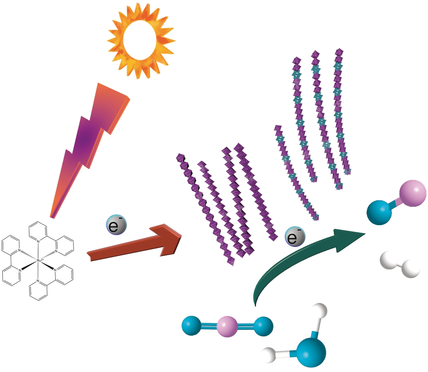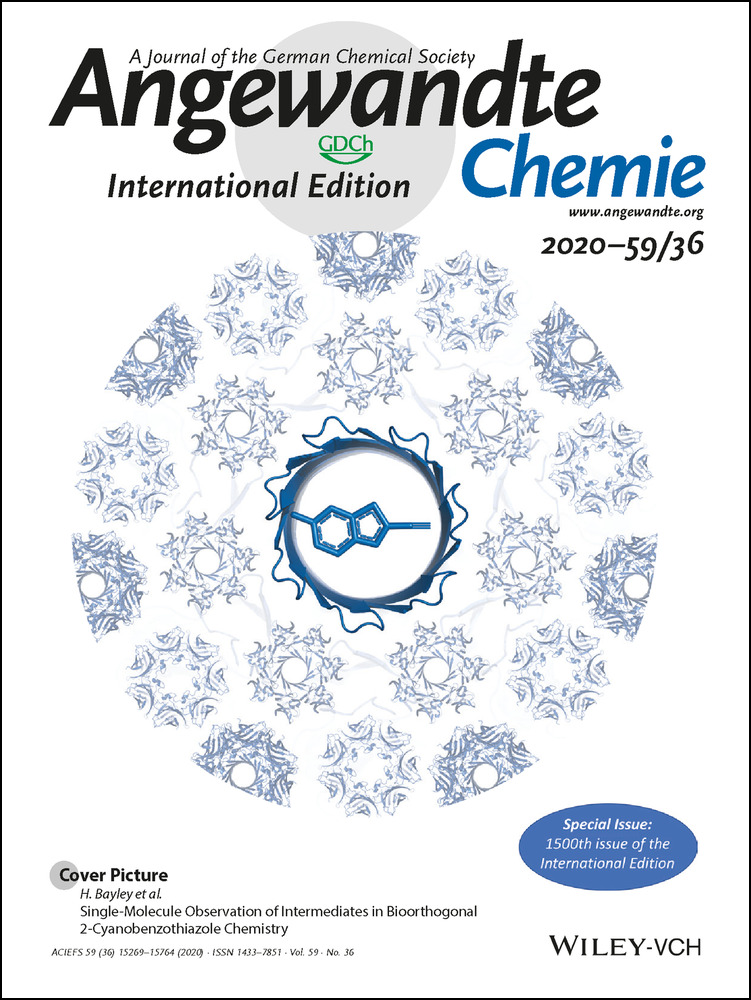POM-Incorporated CoO Nanowires for Enhanced Photocatalytic Syngas Production from CO2
Haozhou Yang
Key Lab of Organic Optoelectronics and Molecular Engineering, Department of Chemistry, Tsinghua University, Beijing, 100084 China
Search for more papers by this authorDeren Yang
Key Lab of Organic Optoelectronics and Molecular Engineering, Department of Chemistry, Tsinghua University, Beijing, 100084 China
Search for more papers by this authorCorresponding Author
Prof. Dr. Xun Wang
Key Lab of Organic Optoelectronics and Molecular Engineering, Department of Chemistry, Tsinghua University, Beijing, 100084 China
Search for more papers by this authorHaozhou Yang
Key Lab of Organic Optoelectronics and Molecular Engineering, Department of Chemistry, Tsinghua University, Beijing, 100084 China
Search for more papers by this authorDeren Yang
Key Lab of Organic Optoelectronics and Molecular Engineering, Department of Chemistry, Tsinghua University, Beijing, 100084 China
Search for more papers by this authorCorresponding Author
Prof. Dr. Xun Wang
Key Lab of Organic Optoelectronics and Molecular Engineering, Department of Chemistry, Tsinghua University, Beijing, 100084 China
Search for more papers by this authorDedicated to Professor Youqi Tang on the occasion of his 100th birthday
Graphical Abstract
POM-incorporated CoO ultrathin nanowires (CoO UNWs) were fabricated by a facile solvothermal method. The UNWs with and without POM incorporation both present superior photocatalysis activities towards syngas production compared with nanowire bundle. Mechanistic studies indicate that size, structure, and composition all contribute to the high performance.
Abstract
Utilizing sustainable energy for chemical activation of small molecules, such as CO2, to produce important chemical feedstocks is highly desirable. The simultaneous production of CO/H2 mixture (syngas) from photoreduction of CO2 and H2O is highly promising. However, the relationships between structure, composition, crystallinity, and photocatalytic performance are still indistinct. Here, amorphous ultrathin CoO nanowires and polyoxometalate incorporated nanowires with even lower crystallinity were synthesized. The POM-incorporated ultrathin nanowires exhibit high photocatalytic syngas production activity, reaching H2 and CO evolution rates of 11555 and 4165 μmol g−1 h−1 respectively. Further experiments indicate that the ultrathin morphology and incorporation of POM both contribute to the superior performance. Multiple characterizations reveal the enhanced charge–hole separation efficiency of the catalyst would facilitate the photocatalysis.
Supporting Information
As a service to our authors and readers, this journal provides supporting information supplied by the authors. Such materials are peer reviewed and may be re-organized for online delivery, but are not copy-edited or typeset. Technical support issues arising from supporting information (other than missing files) should be addressed to the authors.
| Filename | Description |
|---|---|
| anie202004563-sup-0001-misc_information.pdf7.6 MB | Supplementary |
Please note: The publisher is not responsible for the content or functionality of any supporting information supplied by the authors. Any queries (other than missing content) should be directed to the corresponding author for the article.
References
- 1S. C. Peter, ACS Energy Lett. 2018, 3, 1557–1561.
- 2D. U. Nielsen, X.-M. Hu, K. Daasbjerg, T. Skrydstrup, Nat. Catal. 2018, 1, 244–254.
- 3O. S. Bushuyev, P. De Luna, C. T. Dinh, L. Tao, G. Saur, J. van de Lagemaat, S. O. Kelley, E. H. Sargent, Joule 2018, 2, 825–832.
- 4A. Dokania, A. Ramirez, A. Bavykina, J. Gascon, ACS Energy Lett. 2019, 4, 167–176.
- 5M. Aresta, A. Dibenedetto, E. Quaranta, J. Catal. 2016, 343, 2–45.
- 6R. P. Ye, J. Ding, W. Gong, M. D. Argyle, Q. Zhong, Y. Wang, C. K. Russell, Z. Xu, A. G. Russell, Q. Li, M. Fan, Y. G. Yao, Nat. Commun. 2019, 10, 5698.
- 7X. Jiang, X. Nie, X. Guo, C. Song, J. G. Chen, Chem. Rev. 2020, https://doi.org/10.1021/acs.chemrev.9b00723.
- 8Y. Zhao, W. Gao, S. Li, G. R. Williams, A. H. Mahadi, D. Ma, Joule 2019, 3, 920–937.
- 9G. Chen, R. Gao, Y. Zhao, Z. Li, G. I. N. Waterhouse, R. Shi, J. Zhao, M. Zhang, L. Shang, G. Sheng, X. Zhang, X. Wen, L. Z. Wu, C. H. Tung, T. Zhang, Adv. Mater. 2018, 30, 1704663.
- 10V. N. Nguyen, L. Blum, Chem. Ing. Tech. 2015, 87, 354–375.
- 11J. Li, Y. He, L. Tan, P. Zhang, X. Peng, A. Oruganti, G. Yang, H. Abe, Y. Wang, N. Tsubaki, Nat. Catal. 2018, 1, 787–793.
- 12W. Tu, Y. Zhou, Z. Zou, Adv. Mater. 2014, 26, 4607–4626.
- 13N. N. Vu, S. Kaliaguine, T. O. Do, Adv. Funct. Mater. 2019, 29, 1901825.
- 14W. Zhang, A. R. Mohamed, W. J. Ong, Angew. Chem. Int. Ed. 2020, https://doi.org/10.1002/anie.201914925; Angew. Chem. 2020, https://doi.org/10.1002/ange.201914925.
- 15X. Feng, Y. Pi, Y. Song, C. Brzezinski, Z. Xu, Z. Li, W. Lin, J. Am. Chem. Soc. 2020, 142, 690–695.
- 16F. Zhao, Y. Feng, Y. Wang, X. Zhang, X. Liang, Z. Li, F. Zhang, T. Wang, J. Gong, W. Feng, Nat. Commun. 2020, 11, 1443.
- 17G. Chen, G. I. N. Waterhouse, R. Shi, J. Zhao, Z. Li, L. Z. Wu, C. H. Tung, T. Zhang, Angew. Chem. Int. Ed. 2019, 58, 17528–17551; Angew. Chem. 2019, 131, 17690–17715.
- 18C. S. Diercks, Y. Liu, K. E. Cordova, O. M. Yaghi, Nat. Mater. 2018, 17, 301–307.
- 19W. Liu, L. Cao, W. Cheng, Y. Cao, X. Liu, W. Zhang, X. Mou, L. Jin, X. Zheng, W. Che, Q. Liu, T. Yao, S. Wei, Angew. Chem. Int. Ed. 2017, 56, 9312–9317; Angew. Chem. 2017, 129, 9440–9445.
- 20T. Ouyang, H. H. Huang, J. W. Wang, D. C. Zhong, T. B. Lu, Angew. Chem. Int. Ed. 2017, 56, 738–743; Angew. Chem. 2017, 129, 756–761.
- 21B. Ma, G. Chen, C. Fave, L. Chen, R. Kuriki, K. Maeda, O. Ishitani, T. C. Lau, J. Bonin, M. Robert, J. Am. Chem. Soc. 2020, 142, 6188–6195.
- 22S. Wang, W. Yao, J. Lin, Z. Ding, X. Wang, Angew. Chem. Int. Ed. 2014, 53, 1034–1038; Angew. Chem. 2014, 126, 1052–1056.
- 23Y. Wang, N. Y. Huang, J. Q. Shen, P. Q. Liao, X. M. Chen, J. P. Zhang, J. Am. Chem. Soc. 2018, 140, 38–41.
- 24Q.-L. Hong, H.-X. Zhang, J. Zhang, J. Mater. Chem. A 2019, 7, 17272–17276.
- 25C. Gao, Q. Meng, K. Zhao, H. Yin, D. Wang, J. Guo, S. Zhao, L. Chang, M. He, Q. Li, H. Zhao, X. Huang, Y. Gao, Z. Tang, Adv. Mater. 2016, 28, 6485–6490.
- 26S. Wang, B. Y. Guan, X. W. Lou, Energy Environ. Sci. 2018, 11, 306–310.
- 27Y. Wang, S. Wang, X. W. D. Lou, Angew. Chem. Int. Ed. 2019, 58, 17236–17240; Angew. Chem. 2019, 131, 17396–17400.
- 28J. Nai, S. Wang, X. W. D. Lou, Sci. Adv. 2019, 5, eaax5095.
- 29P. Huang, J. Huang, S. A. Pantovich, A. D. Carl, T. G. Fenton, C. A. Caputo, R. L. Grimm, A. I. Frenkel, G. Li, J. Am. Chem. Soc. 2018, 140, 16042–16047.
- 30C. Gao, S. Chen, Y. Wang, J. Wang, X. Zheng, J. Zhu, L. Song, W. Zhang, Y. Xiong, Adv. Mater. 2018, 30, 1704624.
- 31Q. He, D. Liu, J. H. Lee, Y. Liu, Z. Xie, S. Hwang, S. Kattel, L. Song, J. G. Chen, Angew. Chem. Int. Ed. 2020, 59, 3033–3037; Angew. Chem. 2020, 132, 3057–3061.
- 32R. Li, W. Zhang, K. Zhou, Adv. Mater. 2018, 30, 1705512.
- 33Y. Zhang, B. Xia, J. Ran, K. Davey, S. Z. Qiao, Adv. Energy Mater. 2020, 10, 1903879.
- 34H. Yang, X. Wang, Adv. Mater. 2019, 31, 1800743.
- 35B. Akram, B. Ni, X. Wang, Adv. Mater. 2020, 32, 1906794.
- 36B. Akram, W. Shi, H. Zhang, S. Ullah, M. Khurram, X. Wang, Angew. Chem. Int. Ed. 2020, 59, 8497–8501; Angew. Chem. 2020, 132, 8575–8579.
- 37J. Liu, W. Shi, B. Ni, Y. Yang, S. Li, J. Zhuang, X. Wang, Nat. Chem. 2019, 11, 839–845.
- 38Q. Liu, P. He, H. Yu, L. Gu, B. Ni, D. Wang, X. Wang, Sci. Adv. 2019, 5, eaax1081.
- 39L. Xu, Q. Jiang, Z. Xiao, X. Li, J. Huo, S. Wang, L. Dai, Angew. Chem. Int. Ed. 2016, 55, 5277–5281; Angew. Chem. 2016, 128, 5363–5367.
- 40J. Liu, W. Shi, X. Wang, J. Am. Chem. Soc. 2019, 141, 18754–18758.
- 41B. Han, X. Ou, Z. Deng, Y. Song, C. Tian, H. Deng, Y. J. Xu, Z. Lin, Angew. Chem. Int. Ed. 2018, 57, 16811–16815; Angew. Chem. 2018, 130, 17053–17057.
- 42H. Zhong, M. Ghorbani-Asl, K. H. Ly, J. Zhang, J. Ge, M. Wang, Z. Liao, D. Makarov, E. Zschech, E. Brunner, I. M. Weidinger, J. Zhang, A. V. Krasheninnikov, S. Kaskel, R. Dong, X. Feng, Nat. Commun. 2020, 11, 1409.
- 43F. You, J. Wan, J. Qi, D. Mao, N. Yang, Q. Zhang, L. Gu, D. Wang, Angew. Chem. Int. Ed. 2020, 59, 721–724; Angew. Chem. 2020, 132, 731–734.
- 44X. Li, Y. Sun, J. Xu, Y. Shao, J. Wu, X. Xu, Y. Pan, H. Ju, J. Zhu, Y. Xie, Nat. Energy 2019, 4, 690–699.
- 45W. Chen, B. Han, C. Tian, X. Liu, S. Liang, H. Deng, Z. Lin, Appl. Catal. B 2019, 244, 996–1003.
- 46J. H. Kim, M. Lee, C. B. Park, Angew. Chem. Int. Ed. 2014, 53, 6364–6368; Angew. Chem. 2014, 126, 6482–6486.
- 47K. Niu, Y. Xu, H. Wang, R. Ye, H. L. Xin, F. Lin, C. Tian, Y. Lum, K. C. Bustillo, M. M. Doeff, M. T. M. Koper, J. Ager, R. Xu, H. Zheng, Sci. Adv. 2017, 3, e1700921.





